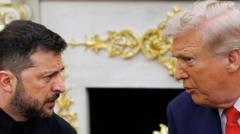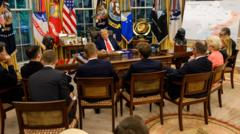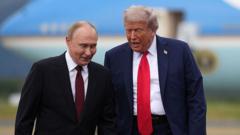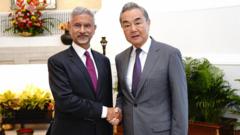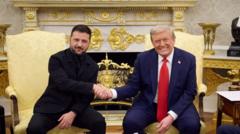As the trade war between China and the U.S. has evolved, recent discussions in Geneva suggest both nations are looking to de-escalate tensions while acknowledging that deeper issues still persist.
China's Trade Talks: Progress, Caution, and Continued Tensions

China's Trade Talks: Progress, Caution, and Continued Tensions
Beijing's recent negotiations with Washington signal a pivotal moment in the ongoing trade conflict, yet significant hurdles remain.
China's steadfast response to U.S. tariffs was a defining feature of this trade conflict. Chinese authorities regularly conveyed an unwavering stance, exemplified by frequent messages from the Ministry of Foreign Affairs declaring, "We will not back down." During previous negotiations, even humor surfaced in state-run media, showcasing contrasting perceptions of the negotiation dynamics.
However, the recent round of talks in Switzerland has led to a moment of cautious optimism. Both sides appear to have recognized the need for continued trade cooperation; U.S. Treasury Secretary Scott Bessent articulated that there is a mutual desire to avoid a decoupling of their economies. This shift is noted as a significant step away from the punitive tariffs which some economists equated to an embargo.
The financial implications are noteworthy. While earlier expectations were for tariffs to be cut by 50%, the current agreement will see U.S. tariffs on Chinese imports reduced to 30%, and Chinese tariffs on U.S. goods falling to 10%. The response from financial markets has been positive, alleviating fears of immediate disruption to global supply chains.
Congressman Trump heralded the discussions as a constructive reset, which was echoed by Chinese officials expressing the hope this agreement will mitigate differences and bolster collaboration. Importantly, there’s a recognition that economic pressures in China, particularly around youth unemployment and low consumer morale, may have contributed to a more conciliatory approach from Beijing.
However, underlying tensions remain. The Chinese Commerce Ministry emphasized the necessity of fair practices while cautioning that their patience has limits, signaling that they will not tolerate perceived injustices. This reflects a desire not only to project strength domestically but also to manage international perceptions.
Experts note that while this represents a temporary truce, the fundamental trade imbalance, where China exports significantly more to the U.S. than it imports, necessitates further negotiations. Moreover, important geopolitical issues, ranging from government subsidies to Taiwan-related tensions, continue to complicate future dealings.
As both nations pivot towards negotiation rather than confrontation, it becomes clear that while progress has been made, the battle for a more equitable trade relationship is far from won — it has merely evolved, with new struggles anticipated on the diplomatic front.
However, the recent round of talks in Switzerland has led to a moment of cautious optimism. Both sides appear to have recognized the need for continued trade cooperation; U.S. Treasury Secretary Scott Bessent articulated that there is a mutual desire to avoid a decoupling of their economies. This shift is noted as a significant step away from the punitive tariffs which some economists equated to an embargo.
The financial implications are noteworthy. While earlier expectations were for tariffs to be cut by 50%, the current agreement will see U.S. tariffs on Chinese imports reduced to 30%, and Chinese tariffs on U.S. goods falling to 10%. The response from financial markets has been positive, alleviating fears of immediate disruption to global supply chains.
Congressman Trump heralded the discussions as a constructive reset, which was echoed by Chinese officials expressing the hope this agreement will mitigate differences and bolster collaboration. Importantly, there’s a recognition that economic pressures in China, particularly around youth unemployment and low consumer morale, may have contributed to a more conciliatory approach from Beijing.
However, underlying tensions remain. The Chinese Commerce Ministry emphasized the necessity of fair practices while cautioning that their patience has limits, signaling that they will not tolerate perceived injustices. This reflects a desire not only to project strength domestically but also to manage international perceptions.
Experts note that while this represents a temporary truce, the fundamental trade imbalance, where China exports significantly more to the U.S. than it imports, necessitates further negotiations. Moreover, important geopolitical issues, ranging from government subsidies to Taiwan-related tensions, continue to complicate future dealings.
As both nations pivot towards negotiation rather than confrontation, it becomes clear that while progress has been made, the battle for a more equitable trade relationship is far from won — it has merely evolved, with new struggles anticipated on the diplomatic front.



